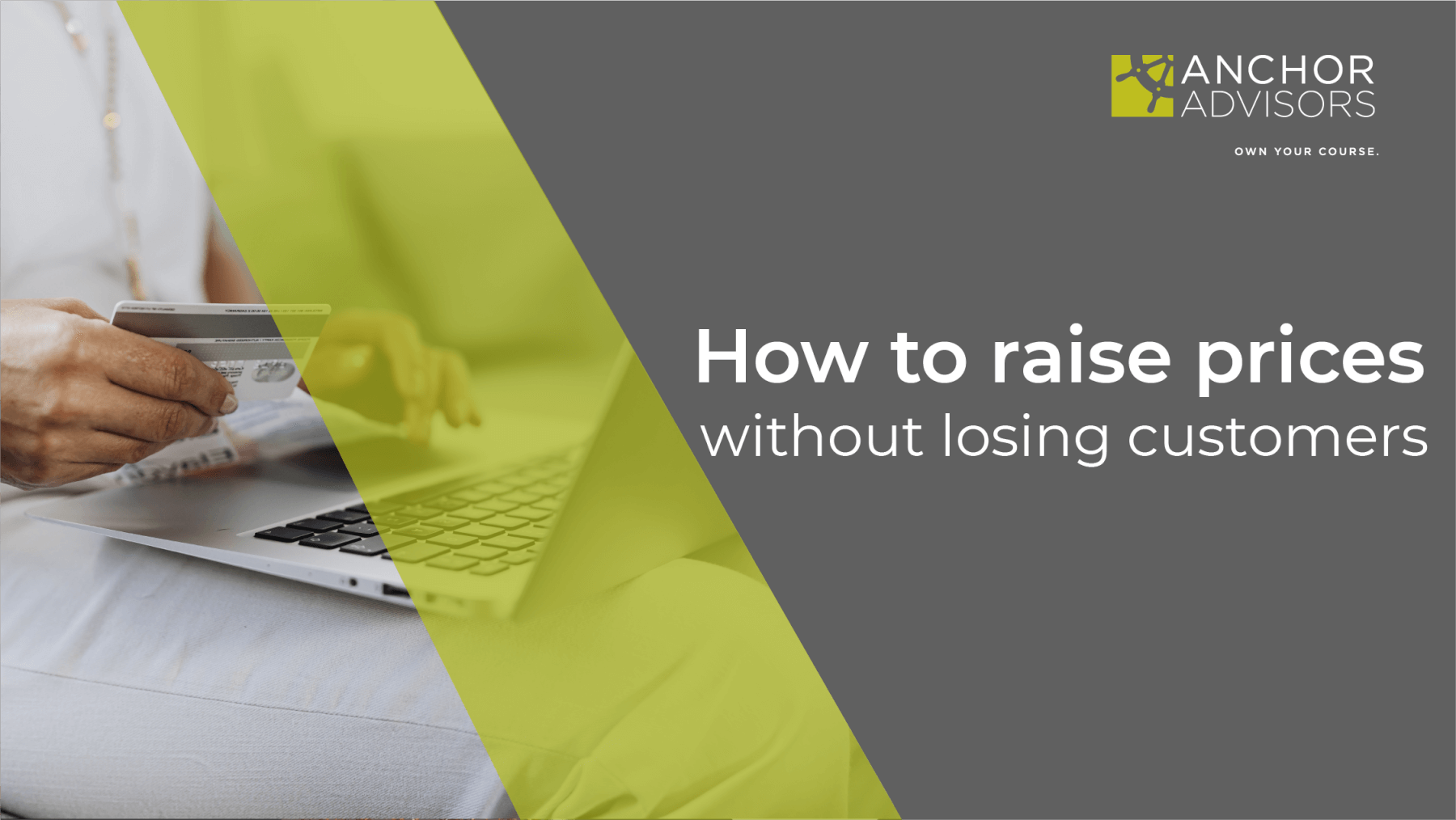How To Raise Prices Without Losing Clients in your Small Business
Adjusting to a Profit Margin Mindset
There’s a strange phenomenon that many entrepreneurs and small businesses suffer from. Fear of raising prices. You’re scared that your customers will pull their business from you if you do.
Yet your business is growing. You’ve got loads of work coming in. So much so that you’ve taken on staff. You’ve increased your tools and your tech. The results speak for themselves. You’re inundated with requests for prices from referral business. Take it from me, you deserve to charge more. And if you don’t you probably won’t make it.
While many many entrepreneurs choose to work long hours, do you really want to work more for less?
I’ve got news for you. Unless you adjust your mindset and raise prices, eventually you’ll have no profits – despite working 24/7. Raising prices is the best of your weapons to increase profits. You’ll get better clients who have more expensive problems – and who really value what you do.
Let’s look at how to reshape your mindset and how to raise your prices without losing customers – essential reading if you have found yourself thinking, “What’s the point?”
Are you ready to uncover all of the secrets to raising your prices successfully? Download the definitive guide to raising your prices now.
Understand the value you bring to the table to raise your rates
Ask yourself, when you work for your customers, what problems are you solving? You’ll discover that the work you do helps your customers to add value to their business by:
- Helping them to sell more
- Improving their efficiency
- Reducing their costs
- Increasing their reach
These are just a few examples. I’m sure you can think of many more ways in which you are a valuable cog in your customers’ businesses.
There’s a price points trap that many entrepreneurs find themselves in. You may already be suffering from it. It’s the time trap. You have become used to charging for your time, instead of your value.
Over the years you have become faster and more efficient at what you do. Yet you still charge by the hour. That’s madness. All that happens is that you do more for the same amount of money. Should you earn less per customer because you’re great at what you do?
If your answer is yes, then stop reading now. If you believe that you are a valuable resource to customers and that you should be earning more, then read on. Let’s discuss how to increase your prices with these 5 steps:
- Don’t ignore your costs
- Know your customer price points
- Decide on your price strategy
- Raise prices to new customers first
- Increase prices to existing clients, and don’t apologize
- Rinse and repeat regularly
(You can read more about value-based pricing in my article “So, what price should I be asking for my services?”)

Step #1: Don’t ignore your costs
Now you’ve decided to move to a value price strategy, you must always keep your profit margins in mind. This means that whenever you price a project you must allow for overheads such as:
- Employee costs
- Outsourcing costs
- Technology (hardware and software)
- Accountant’s fees
- Energy
- Stationary
- Insurances
- Training and development
Everything that you need to run your business has a cost. Even though some of these may not be explicit to the project itself, they must still be paid for. For example, if your accountant fees are, say $1,000, and you have 10 clients, your earnings from each must contribute $100 toward this charge (as a minimum).
Step #2: Know your customer price points
Now, analyze what you are charging your current customers. Many businesses never raise prices on existing customers. Therefore, they manage a complex array of different price points, needing to remember what they charge to each customer.
Not only is this pricing strategy cumbersome, but you also risk subconsciously producing lower quality work for those customers who pay less for the same product or service. If this is happening, you’ll
- Find it harder to raise prices on the work with the lowest profit margin
- Risk losing what may be a high-value customer because of degradation of quality
- Risk damaging your reputation
(Read my article “How to calculate a price increase” for more info)
Are you ready to uncover all of the secrets to raising your prices successfully? Download the definitive guide to raising your prices now.
Step #3: Decide on your price strategy
There are many price strategies that you can employ in value pricing. These include:
-
Competition-based pricing
Your pricing follows the existing market (the going rate), benchmarking against your competitors. What you need to answer is what value do you put on your product or service in relation to your competitors. Pitch too low and you’ll be viewed as a bargain-basement provider (DO NOT DO THIS). Pitch too high and you risk losing out to competitors (You’ll need to prove your value is worth the price).
-
Cost price plus
With this strategy, you simply add an amount on to the cost to produce your product or service to reflect the profit margin you wish to make. Sounds simple enough, but you may not be maximizing your value potential with a cost price plus strategy.
-
Skimming
Skimming is primarily used when selling products. You release the product at the highest possible price, and then as demand subsides or competition increases you gradually reduce the price. You’ll recover your costs faster, but risk alienating customers who bought at the highest prices.
-
Premium pricing
The price you set reflects the high value of your product or service. This reflects your reputation and the exclusivity of your product or services. If you have specific knowledge or experience, a premium pricing strategy for services is easier to introduce.
-
Project-based pricing
Used by businesses such as freelancing, consultants, and contractors, project-based pricing is the opposite of hourly pricing. This gives you the opportunity to maximize your profits, but the risk that if the work takes longer than expected you may be out of pocket or with reduced margins.
-
Bundling
A bundling strategy is when you offer more than one product or service together for a single price. You add value to the product or service your customer is buying. The secret to maximizing your profit here is to ensure that the bundled products or services are complementary and don’t rack up overheads or time for you.
You can also employ psychological pricing models like:
- 3-column pricing – a trial price; a standard price, and a premium price
- Anchor pricing – offering a service at a premium price which then makes the “average” price look lower. The higher price resets the buyer’s expectations, so when you present them your more typical price it seems more reasonable by comparison.
- Price at 9s and 7s – a product priced at $99.99 or $99.97 looks a lot less than one priced at $100
Step #4: Raise prices to new customers first
A good idea is to raise prices to new customers before implementing higher prices to existing customers. This will give you confidence that your new prices are acceptable in the market, provide demonstrable evidence to existing clients, and an immediate replacement for a client should they decide not to pay your new price.
Your starting point for raising prices to new clients is to first learn how to identify new, better clients.
Learn how to find better clients. Download the definitive guide to raising your prices now.
Step #5: Increase prices to existing clients, and don’t apologize
Now that you know the market will readily absorb your price increase, it’s time to raise prices to existing clients. You’ll need to draft a letter or email, and be prepared to explain why you are raising prices.
You should read my post “How to present a price increase so customers stay in love with you”, but some general principles that apply include:
- Let your customers know well in advance
- Remind them of the quality content you provide
- Justify the price increase (e.g., to maintain quality/ ensure continuing consistency of service, etc.)
- Make sure that your whole business is aware of the price increases
- Ensure your customer can contact you for more details/clarification
Step #6: Rinse and Repeat Regularly
Raising prices is not a one-off operation. You should continuously monitor the value you provide, the prices that your competition are charging, and the reaction that your price increases receive.
Are you ready to uncover all of the secrets to raising your prices successfully?
Download the definitive guide to raising your prices now.
Your questions answered
When I discuss how to raise prices without losing customers with my clients, there are several questions that small business owners ask often. I’ve covered many of these in this article, and you can find more detail by following the links provided. Here are a few more that you may be considering asking.
-
What should I do if my customer can’t afford the price increase?
The first thing you should do is ask if they really can’t afford higher prices. Don’t forget, they are in business too and will want to protect their profit margins.
Next, help them to see the value that you provide to them – the extra mile you walk for them, the loyalty you have shown to them in the past, and the quality of your product or service.
If they still won’t budge, you may need to rescope your offer to meet their budget.
Finally, if your customer remains insistent that they cannot afford your new pricing strategy (or they won’t pay higher prices), ask if this is the type of customer you want or need. It could be that this is the wrong customer to be working with (remember, you’ve already onboarded new customers at higher prices).
-
When should I raise my prices?
There are some telltale signs that you must raise your prices, which include:
- You’re too busy
- Low margin clients are destroying your profit margins
- You want to work with fewer clients and make more money
- New customers never try to negotiate, they accept your price immediately – and you know you’ve left money on the table
- Your costs have increase (eg. you’ve hired a better team, added account/project management, etc. to improve the service you are offering. Higher prices will help you to maintain margins)
Once you have taken the plunge and increased your prices, undertake regular price reviews – you won’t ever be afraid to raise prices again.
-
How much should I increase prices by?
I could wax lyrical about how to calculate what you should be charging for thousands of words, but the truth is there is one answer to this question: as much as possible. As much as your market will allow. As much as your customers will pay (and more than you are comfortable with!)
-
How do I justify price increases?
Demonstrate that your products and services are worth the extra money, and show how the value you provide differentiates you from your competitors. When you write a price increase letter to your customers, make it personal – remind them of your close relationship and the long-standing commitment you have shown them, and how you have helped them to develop their business over time.
-
What if I do lose clients?
Depending on your price increase, you can lose some clients and still end up making more money! Less work for more money? That sounds good. To help evaluate your risk I made a quick spreadsheet that you can use to evaluate your situation.
-
Is raising prices easy?
I’ll be honest with you, raising prices takes some effort. It’s not something you can do overnight. You must plan your price increases, know exactly how to explain them to customers, and be prepared for those who want to negotiate with you.
Perhaps the biggest step to take is that first step – shifting your mindset from fear of losing customers. Which is why I’ve written my eBook “How to Raise Your Prices without Losing Your Clients” – download your free copy now.
Move from charging for time to charging for value
There’s a story I once heard, about a maintenance engineer who was called to a factory to fix a machine. The breakdown had caused the whole factory to grind to a halt. Cut a long story short, he examined the machine, and told the Managing Director he could fix the problem. He quoted $10,000.
The MD had no hesitation in agreeing to the price. Every hour of lost production was making a big dent in profits. He agreed that the engineer would start work right away.
The engineer went to his van and returned with a hammer. He climbed the ladder and once more disappeared behind the elephantine equipment. Three taps with the hammer echoed around the silent factory, before the engineer returned to stand by the MD.
“Try it now,” he said to the machine operator. The machine started up immediately.
“You’re charging me ten grand for two minutes of work?” asked the MD incredulously.
“No,” replied the engineer. “The $10,000 bill is to pay for the four years I spent at college, the six years I spent in junior positions learning my trade, and the 20 years of experience I’ve gained since. Plus, all my overheads of running a business. Experience, qualifications, skills, and a business infrastructure that enable you to contact me, and me to know exactly what the problem is and how to fix it so quickly – and get you back up and running faster than any other engineer could have.”
I’ve got a question for you: Why are you still charging for your time, when you should be charging for the value you give?
If there are any questions you have, or any you have after reading “How to Raise Your Prices without Losing Your Clients” please don’t hesitate to contact us. In the meantime, happy price raising!




